Abstract
This study presents the preparation of iron and nitrogen co-doped sludge-based biochar (FeCN-MSBC) and iron oxide-doped biochar (FeO-MSBC) by ball milling municipal sludge with different iron precursors (K3Fe(CN)6 and Fe2O3), followed by pyrolysis. These biochars were utilized to activate persulfate (PMS) for the degradation of phenolic pollutants. The results demonstrate that FeCN-MSBC, formed by the introduction of K3Fe(CN)6, contains Fe/N phases, with surface Fe sites exhibiting a lower oxidation state, which significantly enhances PMS activation efficiency. In contrast, FeO-MSBC, due to the aggregation of Fe2O3/Fe3O4, shows relatively lower catalytic activity. The FeCN-MSBC/PMS system degrades pollutants via a synergistic mechanism involving non-radical pathways mediated by 1O2 and electron transfer processes (ETP) catalyzed by surface Fe. Electrochemical oxidation and quenching experiments confirm that ETP is the dominant pathway. FeCN-MSBC, prepared at a pyrolysis temperature of 600 °C and an Fe loading of 3 mmol/g TSS, exhibited the best performance, achieving a phenol degradation rate constant (kobs) of 0.127 min−1, 4.5 times higher than that of undoped biochar (MSBC). FeCN-MSBC/PMS maintained high efficiency across a wide pH range and in complex water matrices, exhibiting excellent stability over multiple cycles, demonstrating strong potential for practical applications. This study provides an effective strategy for simultaneous Fe and N doping in sludge-derived biochar and offers mechanistic insights into Fe/N synergistic activation of PMS for practical water treatment.
1. Introduction
Biological treatment is the most widely employed process in wastewater management due to its low cost and high efficiency [1,2]. However, wastewater sludge, a solid byproduct generated during biological treatment, contains a variety of potentially hazardous substances such as pathogenic microorganisms, heavy metals, and refractory organic compounds, posing risks to both human health and the environment [3]. Conventional sludge disposal methods, including landfilling, incineration, and composting, often suffer from drawbacks such as high costs and the potential for secondary environmental pollution [4,5]. Therefore, it is of great importance to explore innovative approaches for sludge management. In recent years, pyrolysis for converting sludge into sludge-derived biochar has attracted increasing attention, as it not only ensures the safe disposal of sludge but also enables its resource recovery while effectively reducing greenhouse gas emissions [6,7,8].
Compared with conventional water treatment methods, persulfate-based advanced oxidation processes (PS-AOPs) have attracted increasing attention as an efficient strategy for advanced wastewater remediation, particularly in the degradation of organic pollutants [9,10]. Early studies focused on Fenton and Fenton-like processes driven by •OH [11], followed by the rise in persulfate-based AOPs around 2010, which expanded the role of both radical and non-radical species [12,13,14]. In recent years, biochar has attracted growing attention as a sustainable catalyst, with heteroatom and transition-metal doping strategies shown to significantly enhance its catalytic performance [15]. The surface of biochar, enriched with abundant active sites (e.g., C=O, C–O, –COO, C–N), can effectively activate persulfate to generate diverse reactive oxygen species (ROS), including •OH, SO4•‾, O2•‾, and 1O2. These ROS enable efficient degradation of organic pollutants through both direct oxidation and indirect pathways mediated by electron transfer processes (ETP) [16,17,18]. Feng et al. prepared sludge-based biochar (BS900) by pyrolyzing sludge from a municipal wastewater treatment plant and employed it to activate PMS for the degradation of tetracycline (TC). Graphitic nitrogen and Fe0 served as electron mediators, reducing charge transfer resistance and facilitating the activation of PMS to generate O2•‾ and 1O2 for the degradation of pollutants [19]. Wang et al. prepared sludge-based biochar (SBC) using a one-step pyrolysis method and employed it to activate PMS for the degradation of triclosan (TCS). The dominant active species were •OH, SO4•‾, and singlet oxygen (1O2). The carbon backbone defects and oxygen-containing functional groups were identified as key factors in PMS activation [20].
Biochar materials prepared directly from raw sludge as precursors exhibit limited activation efficiency for persulfate (PS) due to factors such as the high content of inorganic components, and low levels of non-metallic elements, as well as transition metals [21,22]. In fact, nitrogen doping has been found to significantly enhance the catalytic performance of biochar by modulating spin density and charge distribution [23,24]. Specifically, it has been reported that graphitic-N species play a crucial role in the activation of PMS, as the positive charge on the carbon material leads to strong interactions with PMS [24]. Similarly, edge nitrogen species, such as pyridinic-N, have been identified as key reactive sites within biochar [25]. Byambaa et al. prepared nitrogen-doped biochar (HTNBC) by mixing wastewater sludge with ammonium nitrate, followed by hydrothermal pretreatment and high-temperature pyrolysis. This biochar was used to degrade pollutants such as sulfamethoxazole (SMX), 4-chlorophenol (4-CP), and carbamazepine (CBZ). Graphitic nitrogen, pyridinic nitrogen, and carbonyl groups were identified as the primary active sites responsible for PMS activation [26]. The incorporation of transition metals can further modify sludge-based biochar materials. The valence conversion between metals can trigger redox reactions, thereby increasing the generation pathways of reactive oxygen species (ROS) [27]. Iron, a non-toxic transition metal, is abundant in environmental protection areas and is an ideal metal for doping. Wang et al. prepared iron-containing biochar (FeBC) from residual sludge and used it to activate PMS and H2O2, generating free radicals (such as SO4•‾, •OH, and 1O2) for the degradation of pharmaceutical wastewater. Fe(II) activated PMS to produce SO4•‾ and •OH (radical pathway), while the graphitic structure on the biochar surface facilitated the generation of 1O2 (non-radical pathway) [28]. Existing literature on the introduction of Fe sources mainly focuses on endogenous Fe in sludge, while exogenous Fe reagents, such as FeCl3, Fe2O3, and FeSO4, are also commonly used [29,30,31]. For nitrogen sources, chemical reagents such as urea and melamine are typically introduced [32,33], requiring stepwise doping, which complicates practical operations. Additionally, the clustering of Fe leads to low utilization efficiency of Fe, mainly due to the easy hydrolysis of Fe ions during the preparation process [34]. In the case of current single-atom catalysts, Fe precursors usually require coupling with ligands, such as iron acetylacetonate and iron phthalocyanine [35,36]. To prevent Fe clustering, the loading amount of Fe is usually less than 1 wt% [37], which significantly restricts the further enhancement of catalytic performance in Fe-doped biochar.
In this study, K3Fe(CN)6 was introduced as the Fe source for sludge-based biochar. Fe was efficiently mixed with the biochar through a simple ball milling method, followed by pyrolysis to prepare Fe and N co-doped sludge-based biochar (FeCN-MSBC), which was used for activating PMS to efficiently degrade phenolic pollutants. This method allows for the simultaneous doping of Fe and N, and due to the strong coordination between -CN and Fe, it ensures the effective dispersion of Fe, thereby enhancing its utilization. Quenching experiments, radical capture tests, and electrochemical oxidation tests revealed that, unlike other sludge-based biochar/PMS-AOPs systems, the electron transfer process (ETP) mediated by FeCN-MSBC/PMS was identified as the primary pathway for pollutant degradation. This provides a new approach for the efficient utilization of sludge-derived biochar.
2. Results and Discussion
2.1. Characterizations of MSBC with Different Fe Ball Milling Treatment
Scanning electron microscopy (SEM) and transmission electron microscopy (TEM) were performed on the three biochar materials obtained at 600 °C (MSBC, FeCN-MSBC, and FeO-MSBC) (Figure 1a–c). Distinct morphological differences were observed among the samples. MSBC exhibited relatively large, bulky spherical particles with heterogeneous particle sizes. FeO-MSBC displayed irregular block-like structures, where the crystallites predominantly existed in aggregated and stacked forms. Due to the incorporation of Fe2O3, pronounced surface aggregation and clustering of iron oxides were evident. In contrast, FeCN-MSBC showed well-defined and uniformly sized particles, with no obvious clustering phenomena compared to the other materials. Elemental mapping obtained from TEM-EDS analysis further confirmed that the constituent elements were uniformly distributed across the material surface (Figure 1d–r).
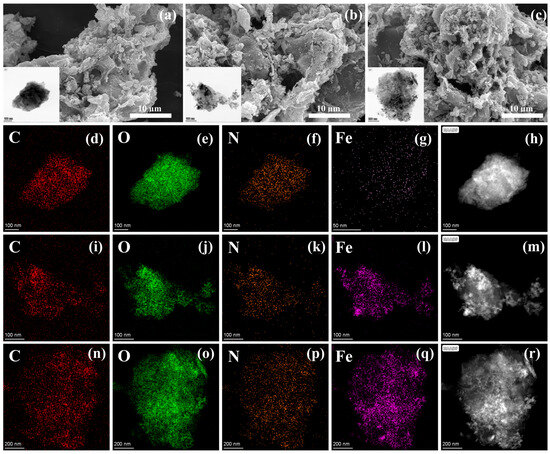
Figure 1.
SEM, TEM (a–c), and TEM-Mapping (d–r) of MSBC, FeCN-MSBC, and FeO-MSBC.
XRD analysis revealed that the surface Fe species of the biochars prepared by ball milling MSBC-400 with different Fe precursors (K3Fe(CN)6 and Fe2O3) varied significantly (Figure 2a). Compared with MSBC, distinct Fe2N signals were detected in FeCN-MSBC, whereas Fe in FeO-MSBC predominantly existed in the forms of Fe2O3 and Fe3O4 [38]. In addition, characteristic diffraction peaks of graphitic carbon were observed in all three biochars, indicating that the sludge biomass underwent graphitization during pyrolysis, leading to the formation of structurally stable biochar materials. These differences in Fe speciation and graphitization degree are expected to play a crucial role in determining the catalytic activity of the biochars [39,40]. Raman spectroscopy results demonstrated that FeCN-MSBC exhibited a lower ID/IG ratio (ID/IG = 2.36) compared with MSBC (ID/IG = 2.57) and FeO-MSBC (ID/IG = 2.58) (Figure 2b). The D band (ID), typically located at ~1300 cm−1, is associated with lattice defects of carbon atoms, whereas the G band (IG), appearing at ~1580 cm−1, corresponds to the in-plane stretching vibration of sp2-hybridized C–C bonds [41]. A lower ID/IG ratio generally indicates fewer structural defects and a higher degree of graphitization in the biochar [42]. In addition, the specific surface areas of the three biochars followed the order: FeCN-MSBC < FeO-MSBC < MSBC, while the average pore size was the largest for FeCN-MSBC (12.9 nm). Evidently, the incorporation of K3Fe(CN)6 reduced the surface area but enlarged the average pore size of the biochar. The UV–Vis DRS results (Figure 2d) indicate that, compared with MSBC and FeO-MSBC, the incorporation of K3Fe(CN)6 facilitates bandgap narrowing in the biochar material, which is more favorable for electron shuttling. Such structural changes may influence the exposure of active sites and mass transfer efficiency, thereby affecting the catalytic performances of the biochars, which will be further investigated.
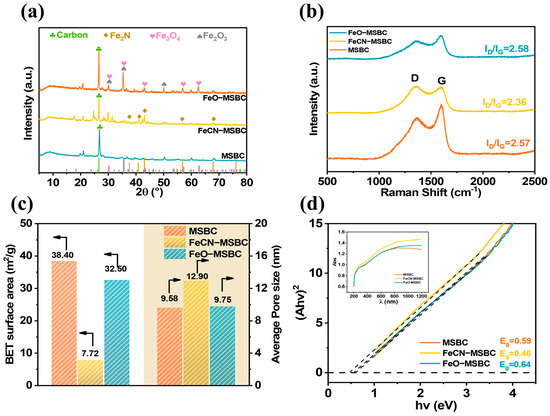
Figure 2.
XRD (a), Raman spectrum (Peak G: Located at approximately 1580 cm−1, it represents the stretching vibration within the carbon atom plane, reflecting the degree of graphite formation and orderliness of the material. Peak D: Located at approximately 1350 cm−1, it represents the vibration mode induced by disorder, used to characterize the degree of defects in the material) (b), BET (The arrow indicates the data reference axis) (c), and UV-Vis DRS (d) characterizations of MSBC, FeCN-MSBC, and FeO-MSBC.
2.2. Distinguishing Key Factors Affecting the Phenol Degradation in the MSBC/PMS Systems
The time-dependent degradation of phenol in the MSBC/PMS, FeCN-MSBC/PMS, and FeO-MSBC/PMS systems was investigated, and the results are shown in Figure 3a. As observed, the phenol degradation rate (pseudo-first-order kinetics) in the FeCN-MSBC/PMS system (kobs = 0.127 min−1) was significantly higher than that in the MSBC/PMS system (kobs = 0.028 min−1), whereas the FeO-MSBC/PMS system exhibited a markedly reduced degradation rate (kobs = 0.016 min−1). These findings indicate that the type of Fe precursor has a pronounced effect on PMS activation, with the incorporation of K3Fe(CN)6-derived Fe species being more favorable for PMS activation. This trend is consistent with the structural characterization results, where the formation of Fe2N in FeCN-MSBC enhanced PMS activation, while the dominance of Fe2O3/Fe3O4 in FeO-MSBC was less effective. Further investigations were conducted on two key parameters affecting the catalytic activity of FeCN-MSBC, namely pyrolysis temperature and the dosage of K3Fe(CN)6. As the pyrolysis temperature increased from 500 to 900 °C, the catalytic activity of FeCN-MSBC first increased and then declined. Since pyrolysis temperature typically influences the degree of graphitization and the specific surface area of biochar [43], the results indicated that FeCN-MSBC exhibited the highest catalytic activity at 600 °C. Similarly, the catalytic activity of FeCN-MSBC as a function of K3Fe(CN)6 loading also followed a volcano-type trend, suggesting that an appropriate Fe doping level is more favorable for enhancing the catalytic performance [44]. Specifically, FeCN-MSBC synthesized at 600 °C with an Fe loading of 3 mmol/g TSS showed the optimum catalytic activity. Unless otherwise specified, FeCN-MSBC mentioned hereafter refers to the material prepared under these conditions.
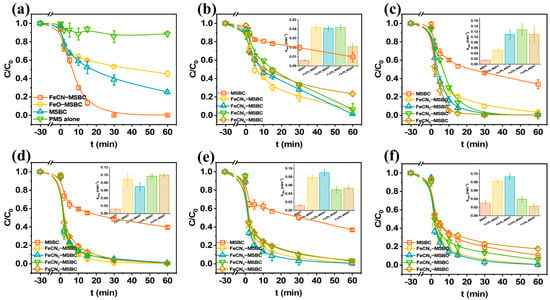
Figure 3.
MSBC, FeCN-MSBC, and FeO-MSBC/PMS degradation rate of Phenol (a), the effect of pyrolysis temperature on FeCNx-MSBC/PMS degradation rate of Phenol (b–f): 500 °C (b), 600 °C (c), 700 °C (d), 800 °C (e), 900 °C (f). Reaction conditions: [Phenol]0 = 50 mg/L; [PMS]0 = 500 mg/L [materials]0 = 0.5 g/L; pH = 6.5.
2.3. Examinations of the Dominant Reactive Species in FeCN-MSBC/PMS System
Radical quenching experiments were conducted to identify the dominant reactive oxygen species (ROS) in the FeCN-MSBC/PMS system (Figure 4a). Four common scavengers were employed, namely methanol (MeOH), tert-butanol (TBA), furfuryl alcohol (FFA), and PMSO [45]. As shown in Figure 3a, MeOH, TBA, and PMSO only exerted slight inhibitory effects on phenol degradation, whereas the presence of FFA almost completely suppressed the reaction. This finding indicates that 1O2, rather than •OH, SO4•‾, or Fe(IV)=O, is the primary ROS in this system. In addition, the introduction of 1.0 mM 1,10-phenanthroline (1,10-Phen) into the FeCN-MSBC/PMS system resulted in a pronounced inhibition of phenol degradation, suggesting that surface Fe sites of FeCN-MSBC serve as the major catalytic centers for PMS activation [46]. This observation is consistent with the XRD results, implying that the Fe2N phase formed in FeCN-MSBC plays a crucial role in PMS activation and 1O2 generation.
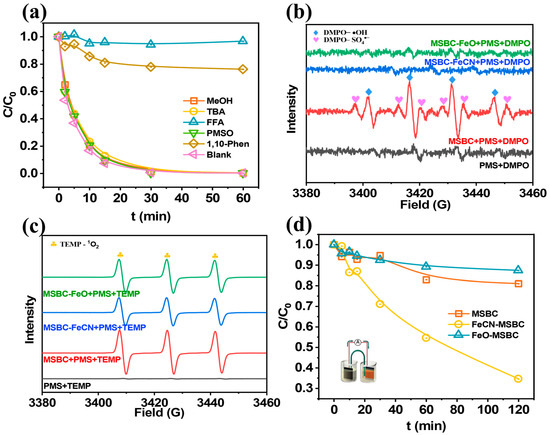
Figure 4.
Reaction rate constant of FeCN-MSBC/PMS/Phenol quenching experiment (a), removal of Phenol in the galvanic oxidation process (GOP); the inset is a diagram of the GOP (b), EPR spectrum of DMPO trapped radical adducts in MSBC/FeCN-MSBC/FeO-MSBC/PMS systems (c), and TEMP trapped 1O2 in MSBC/FeCN-MSBC/FeO-MSBC/PMS systems (d). Reaction conditions: [Phenol]0 = 50 mg/L; [PMS]0 = 500 mg/L [materials]0 = 0.5 g; pH = 6.5.
To further verify the ROS, electron paramagnetic resonance (EPR) analysis was performed using two spin-trapping solutions: PMS + DMPO + H2O and PMS + TMPO + H2O, which are commonly employed for the quantitative detection of •OH/SO4•‾ and 1O2, respectively [47]. As shown in Figure 4b,c, distinct •OH/SO4•‾ and 1O2 signals were observed in the MSBC/PMS system, indicating that both species could act as dominant ROS. This may be attributed to graphitic defects and oxygen-containing functional groups in the biochar, which facilitate electron transfer and promote ROS generation via radical or non-radical pathways. In contrast, the FeCN-MSBC/PMS and FeO-MSBC/PMS systems showed negligible •OH/SO4•‾ signals, and the 1O2 signals were weaker than those in MSBC/PMS. Considering the higher catalytic rate of FeCN-MSBC/PMS, this suggests the presence of additional catalytic pathways.
To explore the potential electron transfer catalysis (ETP) pathway, a galvanic oxidative process (GOP) experiment was conducted, in which PMS and phenol were placed in two separate reactors connected via wires and a salt bridge (Figure 4) [48]. Significant phenol degradation was observed in the FeCN-MSBC/PMS system, whereas no electron transfer catalysis occurred in the MSBC/PMS or FeO-MSBC/PMS systems. Collectively, these results demonstrate that the high catalytic activity of FeCN-MSBC arises from a combination of 1O2-mediated oxidation and surface Fe-catalyzed electron transfer, with Fe2N phases playing a key role in facilitating both pathways.
2.4. Key Factors Affecting the Catalytic Mechanism of the FeCN-MSBC/PMS System
The strong inhibitory effect of 1,10-phenanthroline indicates that surface Fe sites of FeCN-MSBC serve as the key catalytic centers. To further investigate the influence of K3Fe(CN)6 and Fe2O3 doping on the coordination environment of surface Fe, X-ray photoelectron spectroscopy (XPS) analysis was conducted on MSBC, FeCN-MSBC, and FeO-MSBC (Figure 5a–c). XPS analysis was conducted to elucidate the chemical states and coordination environment of Fe, N, and O in the biochars. The Fe 2p spectra show that the peaks at 709.2 eV and 722.8 eV correspond to Fe2+ 2p3/2 and 2p1/2, respectively, while the peaks at 711.2 eV and 724.8 eV are assigned to Fe3+ 2p3/2 and 2p1/2 [49,50]. These results indicate that Fe in FeCN-MSBC exhibits a lower oxidation state compared with FeO-MSBC, which can be attributed to the lower electronegativity of nitrogen in Fe–CN and Fe–N bonds relative to oxygen in Fe–O bonds. The Fe oxidation state is considered a key factor mediating the electron transfer catalysis (ETP) pathway.
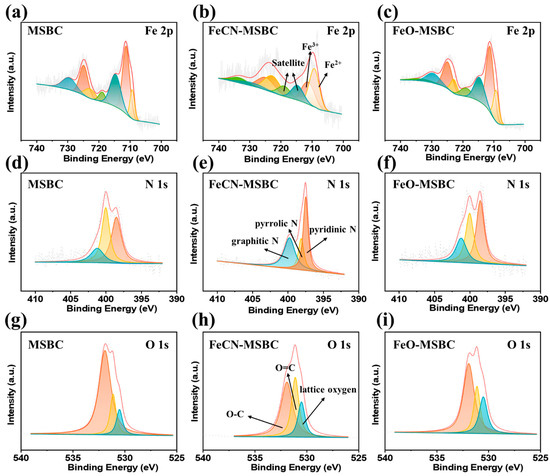
Figure 5.
XPS spectra of Fe 2p (a–c), N 1s (d–f), and O 1s (g–i) for MSBC/FeCN-MSBC/FeO-MSBC.
N 1s analysis further revealed that FeCN-MSBC contains a higher proportion of pyridinic nitrogen compared with MSBC and FeO-MSBC. Pyridinic N is regarded as the key nitrogen species responsible for forming Fe–N coordination sites. Meanwhile, O 1s spectra indicated that FeCN-MSBC possesses a higher content of lattice oxygen, which is considered to facilitate electron transfer processes during the catalytic reaction.
Collectively, these observations suggest that the formation of Fe–N active sites, with Fe in a relatively low oxidation state coordinated to pyridinic N, together with abundant lattice oxygen, plays a crucial role in promoting PMS activation and the ETP pathway in the FeCN-MSBC/PMS system.
2.5. Application of FeCN-MSBC/PMS in Complex Water Matrices
To further evaluate the catalytic activity of FeCN-MSBC/PMS under complex water matrices, phenol degradation experiments were conducted at different initial pH values (pH = 3, 5, 7, 9, 11) (Figure 6a). The results indicated that FeCN-MSBC/PMS maintained high catalytic activity over a wide pH range (pH 3–9) with kobs > 0.12 min−1 and still exhibited considerable activity under strongly alkaline conditions (pH 11, kobs > 0.03 min−1).
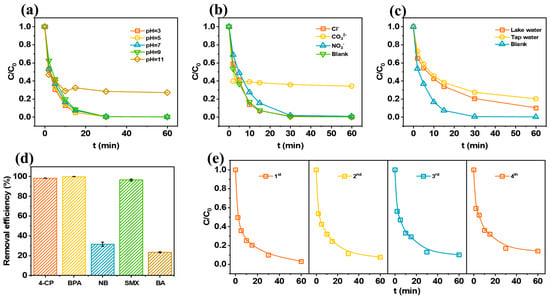
Figure 6.
The effect of initial pH on Phenol degradation (a), common anion interference experiment (b), natural water body interference experiment (c), degradation performance of different phenolic pollutants (d), and FeCN-MSBC cycle stability experiment (e). Reaction conditions: [Pollutant]0 = 50 mg/L; [PMS]0 = 500 mg/L [materials]0 = 0.5 g; pH = 6.5.
The influence of common anions (Cl−, CO32−, NO3−) and natural water matrices (lake water, tap water) on phenol degradation was also investigated (Figure 6b,c). FeCN-MSBC/PMS displayed strong tolerance toward these interferences, which can be attributed to the non-radical pathway dominated by 1O2 and the electron transfer catalysis (ETP) process [51].
To further explore the applicability of FeCN-MSBC/PMS for a broader range of pollutants, the degradation of various phenolic contaminants, including 4-chlorophenol (4-CP), bisphenol A (BPA), nitrobenzene (NB), sulfamethoxazole (SMX), and benzoic acid (BA), was examined. The results showed that electron-rich pollutants, such as 4-CP, BPA, and SMX, were removed with high efficiency (removal rate > 96%). The results of the cycle stability experiment demonstrate that the catalyst retains over 86.1% of its initial activity after four cycles, indicating good reusability and durability, demonstrating the potential of FeCN-MSBC/PMS for practical water treatment applications.
3. Materials and Methods
3.1. Chemicals and Reagents
All chemicals used were of analytical grade and used without further purification. K3Fe(CN)6 (≥99.0%), α-Fe2O3 (150 nm, 99.9%), NaOH (≥99.0%), H2SO4 (≥99.0%), PMS (2KHSO5•KHSO4•K2SO4), phenol (PhOH), p-chlorophenol (4-CP), benzoic acid (BA), bisphenol A (BPA), nitrobenzene (NB), sodium chloride (NaCl), sodium bicarbonate (NaHCO3), Sodium nitrate (NaNO3), methanol (MeOH), tert-butyl alcohol (TBA, ≥ 99%), furfuryl alcohol (FFA ≥ 99.9%), 1,10-phenanthroline (1,10-Phen), methyl phenyl sulfoxide (PMSO) were all purchased from Sinopharm Chemical Reagent Co, Shanghai, China. 5,5-dimethyl-pyrroline-oxide (DMPO ≥ 97%), 2,2,6,6-tetramethyl-1-piperidinyloxy (TEMP) and sulfamethoxazole (SMX) were purchased from Aladdin Co., Shanghai, China. All solutions were prepared in deionized water.
The biochemical sludge used in this study was taken from a local municipal wastewater treatment plant (WWTP). The basic characteristics and inorganic components of the sludge are listed in Table 1.

Table 1.
Characteristics of the raw sludge.
3.2. Preparation of Biochars
Municipal sludge was employed as the precursor for biochar production. The dried sludge was first pyrolyzed at 400 °C for 2 h in a tubular furnace to obtain MSBC-400. Subsequently, MSBC-400 was doped with K3Fe(CN)6 or Fe2O3 at Fe loadings of 1, 2, 3, and 4 mmol/g, followed by ball milling (PM 100, RETSCH, Haan, Germany) at 600 r·min−1 for 1 h. The resulting mixtures were further pyrolyzed at 500–900 °C (heating rate: 10 °C min−1) for 2 h under N2 atmosphere. The products were ground, washed three times with ultrapure water, and dried at 60 °C, and were designated as FeCNx-MSBC (x = 1, 2, 3, 4) and FeO-MSBC, respectively. Unless otherwise specified, FeCN-MSBC refers to the sample prepared at a pyrolysis temperature of 600 °C with an Fe loading of 3 mmol/g TSS (denoted as FeCN3-MSBC). For comparison, sludge biochar prepared under identical conditions without Fe additives was denoted as MSBC.
3.3. Degradation Experiments
Degradation experiments using phenol as the model pollutant were conducted in 100 mL glass beaker reactors. To assess the catalytic performance of the synthesized biochars, a simulated phenol solution (50 mg L−1) was introduced into the reactors under continuous magnetic stirring. The dosage of biochar materials (MSBC, FeCN-MSBC, and FeO-MSBC) was fixed at 0.5 g L−1. Prior to reaction initiation, the suspensions were equilibrated for 30 min to establish adsorption–desorption equilibrium. The reactions were then initiated by adding PMS at the prescribed dosages. At predetermined time intervals, aliquots were withdrawn, filtered through 0.22 μm membranes, and analyzed.
3.4. Analytical Methods
Scanning electron microscopy (SEM, JSM-6330F-FEI/Quanta 400, Tokyo, Japan) and X-ray diffraction analysis (XRD, X’Pert PRO X-ray diffractometer, Almelo, Netherlands) were used to characterize the morphological and crystal structure of the biochars, respectively. X-ray photoelectron spectroscopy (XPS, Thermo Scientific, Waltham, MA, USA) was used to characterize the element valence state of the materials surface, Brunauer–Emmett–Teller analysis (BET, Micromeritics ASAP2460, Norcross, GA, USA) was conducted to test the specific surface area and pore size of the material. The PFRs of the material surface were characterized by EPR spectrometer (Bruker EMX nano, Billerica, MA, USA), CST of sludge was measured with a 304M CST instrument (Triton Electronics, Great Dunmow, UK), the pH of the solution was measured with a Rex laboratory pH meter (PH400F, Shanghai, China), the concentrations of Phenol, BPA, SMX, 4-CP, NB and BA were determined by High Performance Liquid Chromatography (HPLC) combined with UV detector and 18 chromatographic column (4.6 × 25 cm). The mobile phase consisted of 0.1% (v/v) acetic acid and 100% acetonitrile, and the ratio of the two solutions was 40%:60% (v/v). The flow rate was 0.6 mL/min, and the sample volume was 20 μL. The detection wavelength was 270 nm and the column temperature was 35 °C.
4. Conclusions
In this work, Fe and N co-doped sludge-based biochar (FeCN-MSBC) and iron oxide-doped biochar (FeO-MSBC) were successfully prepared by ball milling municipal sludge with K3Fe(CN)6 or Fe2O3, followed by pyrolysis. FeCN-MSBC exhibited superior catalytic activity for PMS activation and phenolic pollutant degradation, attributed to the formation of Fe/N phases, the low oxidation state of surface Fe sites. Mechanistic investigations revealed that FeCN-MSBC/PMS degrades pollutants via a synergistic pathway involving 1O2-mediated non-radical oxidation and surface Fe-catalyzed electron transfer (ETP). Optimal FeCN-MSBC, prepared at 600 °C with 3 mmol/g Fe loading, achieved a phenol degradation rate constant (kobs) of 0.127 min−1, 4.5 times higher than undoped biochar, while maintaining high activity under diverse pH conditions, common anion interferences, and natural water matrices. Furthermore, the material demonstrated good reusability, retaining over 86% of its activity after four cycles. This study provides a practical and efficient approach for the resource recovery of sludge via one-step Fe and N co-doping and elucidates the multi-pathway mechanism of Fe/N synergistic PMS activation, offering a promising strategy for advanced wastewater treatment applications.
Author Contributions
Z.G.: Investigation, data curation, writing—original draft. S.D.: investigation, data curation. M.H.: data curation, visualization. W.-d.O.: writing—editing. X.W.: writing–editing. T.Z.: paper design, writing—review and editing. All authors have read and agreed to the published version of the manuscript.
Funding
This study is financially supported by the National Key Technical Research and Development Program of China (2023YFC3207204), the National Natural Science Foundation of China (Nos. 22106159 and 21677055), and the Leading Plan for Scientific and Technological Innovation of High-Tech Industries in Hunan Province (2021GK4060). Huazhong University of Science and Technology’s Analytic and Testing Center is thanked for its advanced analytical operations.
Data Availability Statement
The datasets used or analyzed during the current study are available from the corresponding author upon reasonable request.
Conflicts of Interest
The authors declare no conflicts of interest.
References
- Samer, M. Biological and Chemical Wastewater Treatment. In Wastewater Treatment Engineering; InTech: Rijeka, Croatia, 2015; pp. 1–50. [Google Scholar]
- Tang, J.; Zhang, C.; Shi, X.; Sun, J.; Cunningham, J.A. Municipal wastewater treatment plants coupled with electrochemical, biological and bio-electrochemical technologies: Opportunities and challenge toward energy self-sufficiency. J. Environ. Manag. 2019, 234, 396–403. [Google Scholar] [CrossRef]
- Mantis, I.; Voutsa, D.; Samara, C. Assessment of the environmental hazard from municipal and industrial wastewater treatment sludge by employing chemical and biological methods. Ecotoxicol. Environ. Saf. 2005, 62, 397–407. [Google Scholar] [CrossRef]
- Deleris, S.; Geaugey, V.; Camacho, P.; Debellefontaine, H.; Paul, E. Minimization of sludge production in biological processes: An alternative solution for the problem of sludge disposal. Water Sci. Technol. 2002, 46, 63–70. [Google Scholar] [CrossRef] [PubMed]
- Ødegaard, H.; Paulsrud, B.; Karlsson, I. Wastewater sludge as a resource: Sludge disposal strategies and corresponding treatment technologies aimed at sustainable handling of wastewater sludge. Water Sci. Technol. 2002, 46, 295–303. [Google Scholar] [CrossRef] [PubMed]
- Singh, S.; Kumar, V.; Dhanjal, D.S.; Datta, S.; Bhatia, D.; Dhiman, J.; Samuel, J.; Prasad, R.; Singh, J. A sustainable paradigm of sewage sludge biochar: Valorization, opportunities, challenges and future prospects. J. Clean. Prod. 2020, 269, 122259. [Google Scholar] [CrossRef]
- Goldan, E.; Nedeff, V.; Barsan, N.; Culea, M.; Tomozei, C.; Panainte-Lehadus, M.; Mosnegutu, E. Evaluation of the use of sewage sludge biochar as a soil amendment—A review. Sustainability 2022, 14, 5309. [Google Scholar] [CrossRef]
- Zhao, L.; Sun, Z.-F.; Pan, X.-W.; Tan, J.-Y.; Yang, S.-S.; Wu, J.-T.; Chen, C.; Yuan, Y.; Ren, N.-Q. Sewage sludge derived biochar for environmental improvement: Advances, challenges, and solutions. Water Res. X 2023, 18, 100167. [Google Scholar] [CrossRef]
- Ike, I.A.; Linden, K.G.; Orbell, J.D.; Duke, M. Critical review of the science and sustainability of persulphate advanced oxidation processes. Chem. Eng. J. 2018, 338, 651–669. [Google Scholar] [CrossRef]
- Yan, Y.; Wei, Z.; Duan, X.; Long, M.; Spinney, R.; Dionysiou, D.D.; Xiao, R.; Alvarez, P.J. Merits and limitations of radical vs. nonradical pathways in persulfate-based advanced oxidation processes. Environ. Sci. Technol. 2023, 57, 12153–12179. [Google Scholar] [CrossRef]
- Babuponnusami, A.; Muthukumar, K. A review on Fenton and improvements to the Fenton process for wastewater treatment. J. Environ. Chem. Eng. 2014, 2, 557–572. [Google Scholar] [CrossRef]
- Liang, C.; Guo, Y.-Y.; Chien, Y.-C.; Wu, Y.-J. Oxidative degradation of MTBE by pyrite-activated persulfate: Proposed reaction pathways. Ind. Eng. Chem. Res. 2010, 49, 8858–8864. [Google Scholar] [CrossRef]
- Fang, G.-D.; Dionysiou, D.D.; Wang, Y.; Al-Abed, S.R.; Zhou, D.-M. Sulfate radical-based degradation of polychlorinated biphenyls: Effects of chloride ion and reaction kinetics. J. Hazard. Mater. 2012, 227, 394–401. [Google Scholar] [CrossRef]
- Saien, J.; Soleymani, A.; Sun, J. Parametric optimization of individual and hybridized AOPs of Fe2+/H2O2 and UV/S2O82− for rapid dye destruction in aqueous media. Desalination 2011, 279, 298–305. [Google Scholar] [CrossRef]
- Kang, Z.; Jia, X.; Zhang, Y.; Kang, X.; Ge, M.; Liu, D.; Wang, C.; He, Z. A review on application of biochar in the removal of pharmaceutical pollutants through adsorption and persulfate-based AOPs. Sustainability 2022, 14, 10128. [Google Scholar] [CrossRef]
- Wang, C.; Huang, R.; Sun, R.; Yang, J.; Sillanpää, M. A review on persulfates activation by functional biochar for organic contaminants removal: Synthesis, characterizations, radical determination, and mechanism. J. Environ. Chem. Eng. 2021, 9, 106267. [Google Scholar] [CrossRef]
- Yu, J.; Tang, L.; Pang, Y.; Zhou, Y.; Feng, H.; Ren, X.; Tang, J.; Wang, J.; Deng, L.; Shao, B. Non-radical oxidation by N, S, P co-doped biochar for persulfate activation: Different roles of exogenous P/S doping, and electron transfer path. J. Clean. Prod. 2022, 374, 133995. [Google Scholar] [CrossRef]
- Yu, J.; Gong, Z.; Wang, S.; Zhong, H.; Tao, Y.; Hou, Y.; Fu, Q.; Yang, H.; Li, J.; Wang, J. Two major deactivation mechanisms in carbon-based advanced oxidation processes (AOPs) dominated by electron-transfer pathway (ETP). Appl. Catal. B Environ. Energy 2025, 364, 124850. [Google Scholar] [CrossRef]
- Feng, Y.; Liu, M.; Shi, Q.; Song, Y.; Yang, L.; Zhang, J.; Li, Z.; Zhu, W. Sludge-derived biochar applied in peroxymonosulfate (PMS) activation: Reactive oxygen species (ROS) dominated process and characteristics. J. Environ. Chem. Eng. 2023, 11, 111365. [Google Scholar] [CrossRef]
- Wang, S.; Wang, J. Activation of peroxymonosulfate by sludge-derived biochar for the degradation of triclosan in water and wastewater. Chem. Eng. J. 2019, 356, 350–358. [Google Scholar] [CrossRef]
- Udayanga, W.C.; Veksha, A.; Giannis, A.; Lisak, G.; Lim, T.-T. Effects of sewage sludge organic and inorganic constituents on the properties of pyrolysis products. Energy Convers. Manag. 2019, 196, 1410–1419. [Google Scholar] [CrossRef]
- Zielińska, A.; Oleszczuk, P.; Charmas, B.; Skubiszewska-Zięba, J.; Pasieczna-Patkowska, S. Effect of sewage sludge properties on the biochar characteristic. J. Anal. Appl. Pyrolysis 2015, 112, 201–213. [Google Scholar] [CrossRef]
- Ye, S.; Zeng, G.; Tan, X.; Wu, H.; Liang, J.; Song, B.; Tang, N.; Zhang, P.; Yang, Y.; Chen, Q. Nitrogen-doped biochar fiber with graphitization from Boehmeria nivea for promoted peroxymonosulfate activation and non-radical degradation pathways with enhancing electron transfer. Appl. Catal. B Environ. 2020, 269, 118850. [Google Scholar] [CrossRef]
- Duan, X.; Sun, H.; Wang, Y.; Kang, J.; Wang, S. N-doping-induced nonradical reaction on single-walled carbon nanotubes for catalytic phenol oxidation. Acs Catal. 2015, 5, 553–559. [Google Scholar] [CrossRef]
- Xu, L.; Wu, C.; Liu, P.; Bai, X.; Du, X.; Jin, P.; Yang, L.; Jin, X.; Shi, X.; Wang, Y. Peroxymonosulfate activation by nitrogen-doped biochar from sawdust for the efficient degradation of organic pollutants. Chem. Eng. J. 2020, 387, 124065. [Google Scholar] [CrossRef]
- Byambaa, B.; Kim, E.-J.; Seid, M.G.; An, B.-M.; Cho, J.; Aung, S.L.; Song, K.G. Synthesis of N-doped sludge biochar using the hydrothermal route-enabled carbonization method for the efficient degradation of organic pollutants by peroxymonosulfate activation. Chem. Eng. J. 2023, 456, 141037. [Google Scholar] [CrossRef]
- Peng, X.; Wu, J.; Zhao, Z.; Wang, X.; Dai, H.; Li, Y.; Wei, Y.; Xu, G.; Hu, F. High efficiency degradation of tetracycline by peroxymonosulfate activated with Fe/NC catalysts: Performance, intermediates, stability and mechanism. Environ. Res. 2022, 205, 112538. [Google Scholar] [CrossRef]
- Wang, Z.; Gao, B.; Liu, J.; Sillanpää, M.; Kim, Y. The oxidation treatment of pharmaceutical wastewater in H2O2 and PMS system by Iron-containing biochar originated from excess sludge. J. Water Process Eng. 2024, 58, 104833. [Google Scholar] [CrossRef]
- Wu, Q.; Zhang, Y.; Liu, H.; Liu, H.; Tao, J.; Cui, M.H.; Zheng, Z.; Wen, D.; Zhan, X. Fe(x)N produced in pharmaceutical sludge biochar by endogenous Fe and exogenous N doping to enhance peroxymonosulfate activation for levofloxacin degradation. Water Res. 2022, 224, 119022. [Google Scholar] [CrossRef] [PubMed]
- Zeng, S.; Kan, E. FeCl3-activated biochar catalyst for heterogeneous Fenton oxidation of antibiotic sulfamethoxazole in water. Chemosphere 2022, 306, 135554. [Google Scholar] [CrossRef]
- Xu, H.; Zhang, X.; Zhang, Y. Modification of biochar by Fe2O3 for the removal of pyridine and quinoline. Environ. Technol. 2018, 39, 1470–1480. [Google Scholar] [CrossRef]
- Luo, J.; Yi, Y.; Fang, Z. Nitrogen-rich magnetic biochar prepared by urea was used as an efficient catalyst to activate persulfate to degrade organic pollutants. Chemosphere 2023, 339, 139614. [Google Scholar] [CrossRef]
- Mian, M.M.; Liu, G.; Zhou, H. Preparation of N-doped biochar from sewage sludge and melamine for peroxymonosulfate activation: N-functionality and catalytic mechanisms. Sci. Total Environ. 2020, 744, 140862. [Google Scholar] [CrossRef] [PubMed]
- Hu, X.; Ding, Z.; Zimmerman, A.R.; Wang, S.; Gao, B. Batch and column sorption of arsenic onto iron-impregnated biochar synthesized through hydrolysis. Water Res. 2015, 68, 206–216. [Google Scholar] [CrossRef] [PubMed]
- Li, Z.; Zhong, X.; Gao, L.; Hu, J.; Peng, W.; Wang, X.; Zhou, G.; Xu, B. Asymmetric coordination of bimetallic Fe–Co single-atom pairs toward enhanced bifunctional activity for rechargeable zinc–air batteries. ACS Nano 2024, 18, 13006–13018. [Google Scholar] [CrossRef] [PubMed]
- Wu, Y.; Chen, J.; Liu, J.; Zhang, L.; Abazari, R.; Li, T.-T.; Qian, J. Iron phthalocyanine coupled with Co-Nx sites in carbon nanostraws for Zn-Air batteries. Chem. Eng. J. 2025, 503, 158343. [Google Scholar] [CrossRef]
- Lu, X.; Li, Y.; Yang, P.; Wan, Y.; Wang, D.; Xu, H.; Liu, L.; Xiao, L.; Li, R.; Wang, G. Atomically dispersed Fe-NC catalyst with densely exposed Fe-N4 active sites for enhanced oxygen reduction reaction. Chem. Eng. J. 2024, 485, 149529. [Google Scholar] [CrossRef]
- Ahmed, S.; Yoon, W.; Jo, H.; Irshad, M.; Khan, M.K.; Kim, J. Structure-activity relationship and deactivation behavior of iron oxide during CO2 hydrogenation. Chem. Eng. J. 2024, 499, 156104. [Google Scholar] [CrossRef]
- Liang, C.; Sun, H.; Ling, C.; Liu, X.; Li, M.; Zhang, X.; Guo, F.; Zhang, X.; Shi, Y.; Cao, S.; et al. Pyrolysis temperature-switchable Fe-N sites in pharmaceutical sludge biochar toward peroxymonosulfate activation for efficient pollutants degradation. Water Res. 2023, 228 Pt A, 119328. [Google Scholar] [CrossRef]
- Bayoka, H.; Snoussi, Y.; Bhakta, A.K.; El Garah, M.; Khalil, A.M.; Jouini, M.; Ammar, S.; Chehimi, M.M. Evidencing the synergistic effects of carbonization temperature, surface composition and structural properties on the catalytic activity of biochar/bimetallic composite. J. Anal. Appl. Pyrolysis 2023, 173, 106069. [Google Scholar] [CrossRef]
- Urbonaite, S.; Hälldahl, L.; Svensson, G. Raman spectroscopy studies of carbide derived carbons. Carbon 2008, 46, 1942–1947. [Google Scholar] [CrossRef]
- Ni, Z.; Fan, H.; Fan, X.; Wang, H.; Zheng, Z.; Feng, Y.; Wu, Y.; Shen, Z. High temperature Raman spectroscopy studies of carbon nanowalls. J. Raman Spectrosc. 2007, 38, 1449–1453. [Google Scholar] [CrossRef]
- Chen, C.; Sun, K.; Huang, C.; Yang, M.; Fan, M.; Wang, A.; Zhang, G.; Li, B.; Jiang, J.; Xu, W. Investigation on the mechanism of structural reconstruction of biochars derived from lignin and cellulose during graphitization under high temperature. Biochar 2023, 5, 51. [Google Scholar] [CrossRef]
- Liu, H.; Ye, C.; Xu, Y.; Wang, Q. Effect of activation conditions and iron loading content on the catalytic cracking of toluene by biochar. Energy 2022, 247, 123409. [Google Scholar] [CrossRef]
- Yang, Y.; Banerjee, G.; Brudvig, G.W.; Kim, J.-H.; Pignatello, J.J. Oxidation of organic compounds in water by unactivated peroxymonosulfate. Environ. Sci. Technol. 2018, 52, 5911–5919. [Google Scholar] [CrossRef]
- Zhu, R.; Shi, Y.; Zhou, Y.; Xia, Y.; Qi, Q.; Liang, X.; Kuang, M.; Jia, Z.; Wang, M.; Yu, C. Highly reactive iron/nickel bimetallic biochar composites for highly efficient remediation of Cr (vi). New J. Chem. 2025, 49, 4427–4437. [Google Scholar] [CrossRef]
- Sun, Y.; Jing, Y.; Wang, Z.; Huang, M.; Oh, W.-D.; Wu, X.; Zhou, T. Regulating sulfur vacancies formation on mechanochemically modified pyrite to steer non-radical molecular oxygen activation for water purification. Sep. Purif. Technol. 2025, 353, 128572. [Google Scholar] [CrossRef]
- Zhang, L.S.; Jiang, X.H.; Zhong, Z.A.; Tian, L.; Sun, Q.; Cui, Y.T.; Lu, X.; Zou, J.P.; Luo, S.L. Carbon Nitride Supported High-Loading Fe Single-Atom Catalyst for Activation of Peroxymonosulfate to Generate 1O2 with 100 % Selectivity. Angew. Chem. Int. Ed. 2021, 60, 21751–21755. [Google Scholar] [CrossRef]
- Wang, B.-B.; Shi, X.; Liu, X.-T.; Zou, J.-T.; Li, H.-J.; Peng, D.-C.; He, F. Insight into the fenton-induced degradation process of extracellular polymeric substances (EPS) extracted from activated sludge. Chemosphere 2019, 234, 318–327. [Google Scholar] [CrossRef]
- Zhang, X.; Liu, Y.; Li, J.; Wei, Z.; Duan, W.; Chen, F. Enhancing effects of sludge biochar on aerobic granular sludge for wastewater treatment. Processes 2022, 10, 2385. [Google Scholar] [CrossRef]
- Liu, Y.; Tian, Q.; Chen, Y.; Guo, T.; Zhang, Y.; Huang, Z.; Hu, H.; Gan, T. Single-atom Fe catalysts anchored on graphitized chitin-derived carbon for improved anti-interference ability of Fenton-like reaction via non-radical pathway. Appl. Surf. Sci. 2024, 660, 160020. [Google Scholar] [CrossRef]
Disclaimer/Publisher’s Note: The statements, opinions and data contained in all publications are solely those of the individual author(s) and contributor(s) and not of MDPI and/or the editor(s). MDPI and/or the editor(s) disclaim responsibility for any injury to people or property resulting from any ideas, methods, instructions or products referred to in the content. |
© 2025 by the authors. Licensee MDPI, Basel, Switzerland. This article is an open access article distributed under the terms and conditions of the Creative Commons Attribution (CC BY) license (https://creativecommons.org/licenses/by/4.0/).